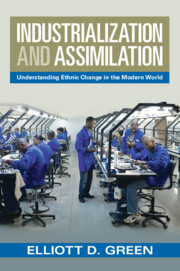Book contents
- Industrialization and Assimilation
- Industrialization and Assimilation
- Copyright page
- Dedication
- Epigraph
- Contents
- Figures
- Maps
- Tables
- Acknowledgements
- 1 Introduction
- 2 Understanding Ethnicity and Industrialization
- 3 Industrialization and Assimilation in Historical Perspective
- 4 Cross-National Evidence
- 5 Industrialization and Assimilation in Mid-twentieth-Century Turkey
- 6 Cases of Non-industrialization in Africa
- 7 ‘Cattle without Legs’
- 8 Ethnic Change among Native Americans in the United States
- 9 Ethnic Change among the Māori in New Zealand
- 10 Conclusion
- Appendix Country-Level Data Used in Chapter 4
- Bibliography
- Index
10 - Conclusion
Published online by Cambridge University Press: 18 November 2022
- Industrialization and Assimilation
- Industrialization and Assimilation
- Copyright page
- Dedication
- Epigraph
- Contents
- Figures
- Maps
- Tables
- Acknowledgements
- 1 Introduction
- 2 Understanding Ethnicity and Industrialization
- 3 Industrialization and Assimilation in Historical Perspective
- 4 Cross-National Evidence
- 5 Industrialization and Assimilation in Mid-twentieth-Century Turkey
- 6 Cases of Non-industrialization in Africa
- 7 ‘Cattle without Legs’
- 8 Ethnic Change among Native Americans in the United States
- 9 Ethnic Change among the Māori in New Zealand
- 10 Conclusion
- Appendix Country-Level Data Used in Chapter 4
- Bibliography
- Index
Summary
Finally, in Chapter 10 I close the book by discussing some broader conclusions about the study of ethnicity and ethnic change, while also speculating about future prospects for the relationship between industrialization and assimilation. In the former case I focus on such topics as future quantitative work using data on ethnicity, our understanding of individuals who change their ethnic identities, the role of the state in enforcing or promoting ethnic identification and policy implications as regards promoting industrialization. In the latter case I return to my original dataset of country censuses from Chapter 4 to see if the relationship between industrialization and ethnic diversity changes over time. Upon introducing an interaction effect, I find evidence for a declining effect over time, although it appears that the interaction effect is driven by observations from the Americas, a result for which I find evidence in the secondary literature as well.
Keywords
- Type
- Chapter
- Information
- Industrialization and AssimilationUnderstanding Ethnic Change in the Modern World, pp. 212 - 228Publisher: Cambridge University PressPrint publication year: 2022

